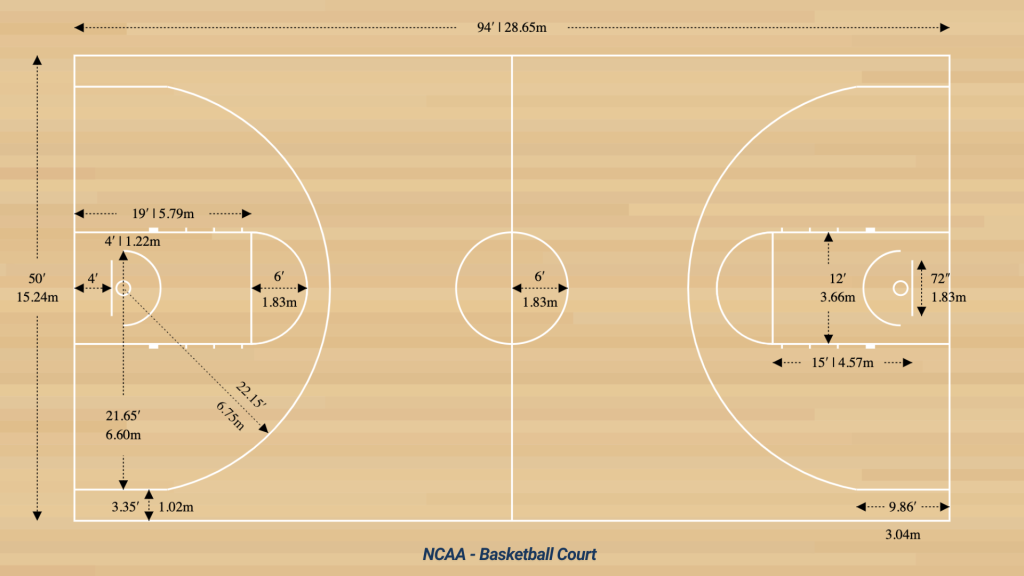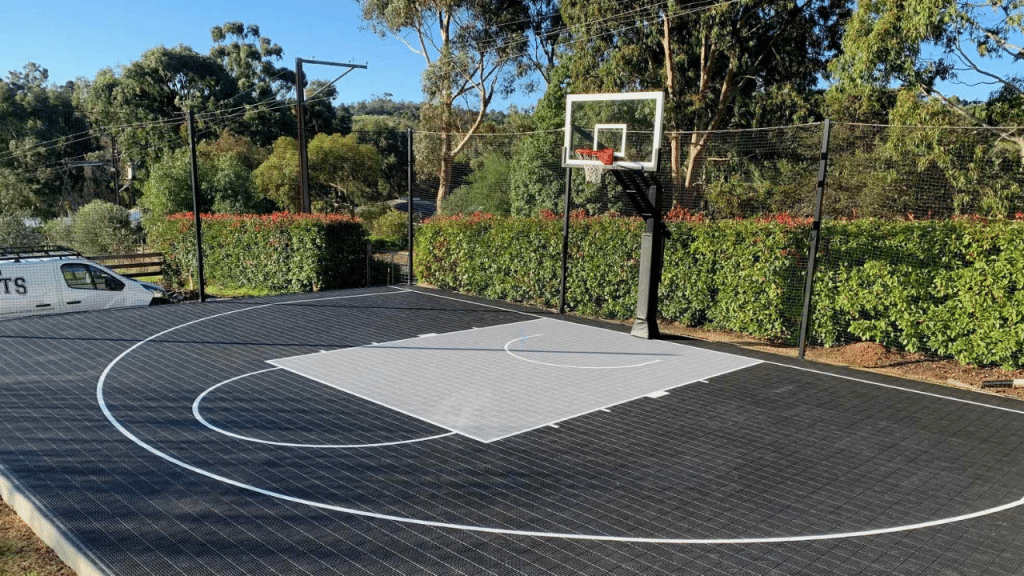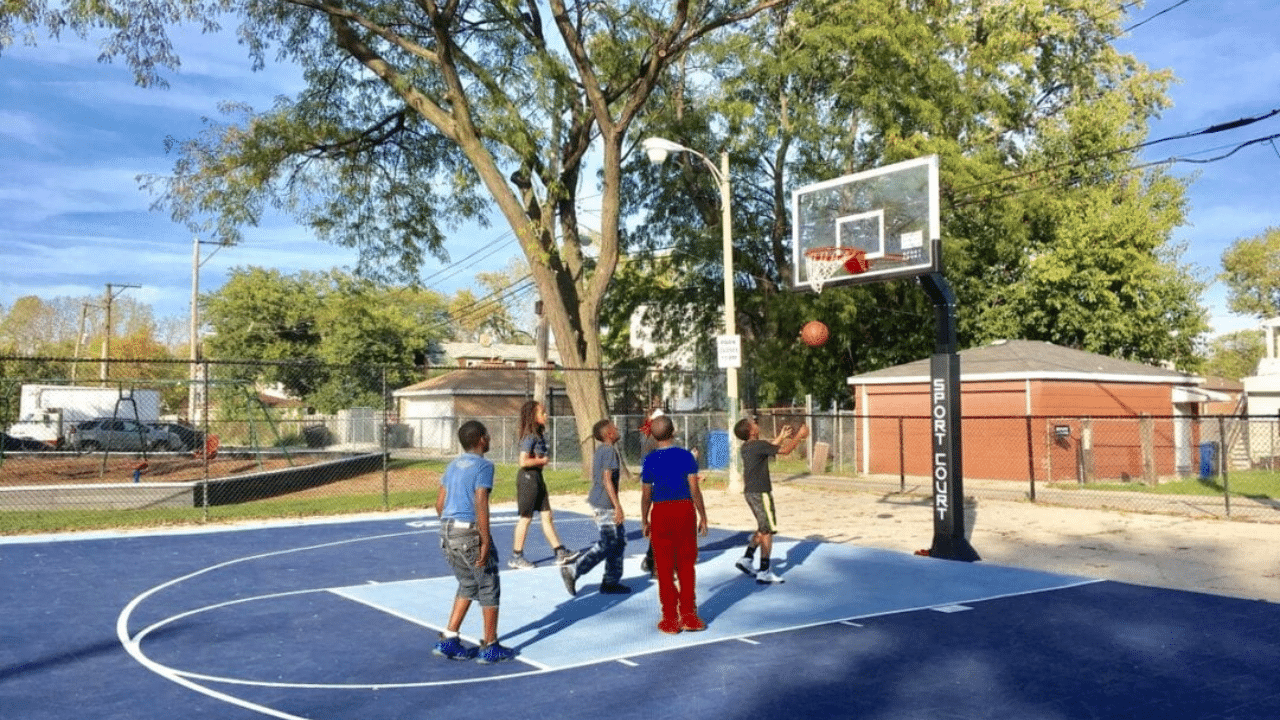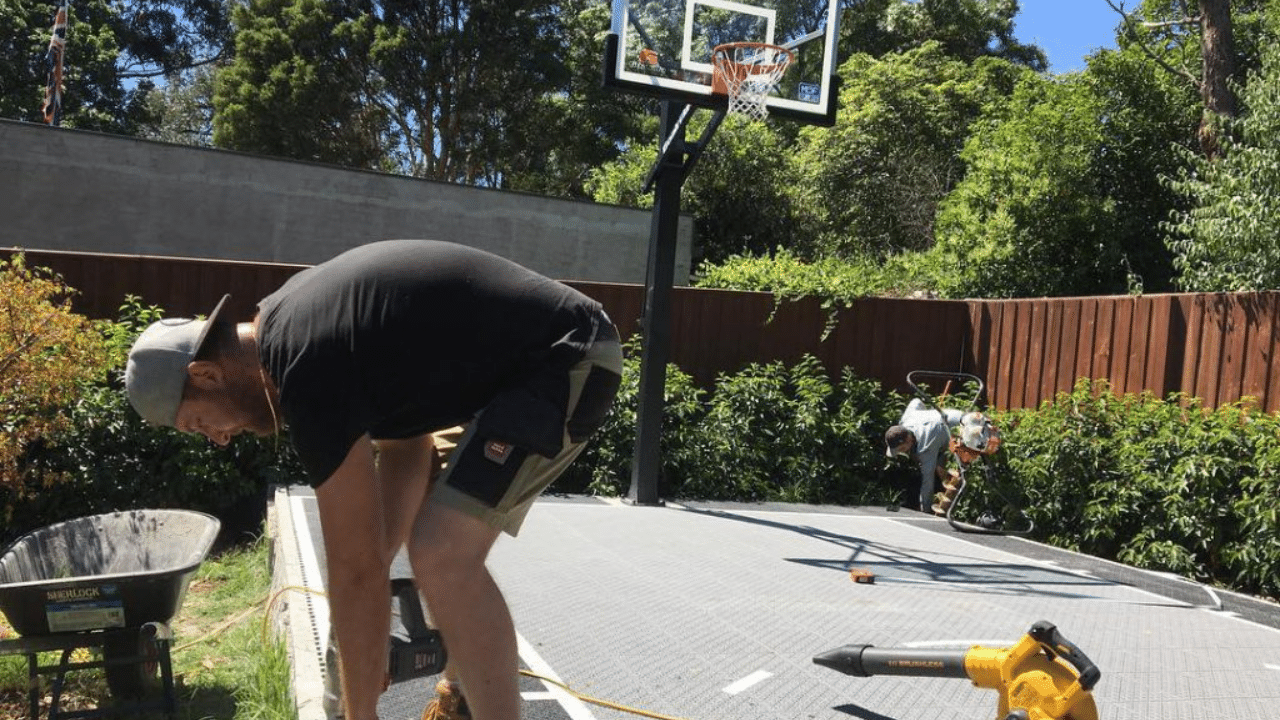When space is tight, but the love for the game runs deep, a half-court setup is all you need. From backyards to training gyms, half-court basketball offers a faster pace, smarter play, and a practical solution for anyone serious about the sport.
But getting it right isn’t just about throwing down a hoop and calling it a day. The dimensions matter—and so do the markings.
From high school to pro-level setups, each standard comes with specific measurements that can make or break your game flow.
If you’re building a court or just want to understand what regulation half-court play looks like, this guide gives you the full breakdown.
No guesswork. No wasted space. Just clear, court-ready numbers that help you create a space that works. Get ready to measure, mark, and build something that actually plays the way it should.
Breakdown of Basketball Court Size by Level

A basketball court is a structured space that supports high-speed action, teamwork, and strategy. From the paint to the arc, each part of the court serves a purpose.
Layouts may vary slightly by level, but the core elements—like spacing, shooting zones, and boundary lines—shape how the game is played.
Full-sized courts used in professional, college, and high school settings share similar widths, with length being the main difference. These standards allow players to develop timing, court awareness, and spacing skills appropriate to their level of play.
Every court, regardless of level, follows these standards to keep the game fair, challenging, and exciting. When it’s built right, the court becomes part of the strategy.
For specific measurements, see the full comparison table below.
| Feature | NBA | NCAA | High School |
|---|---|---|---|
| Full Court Length | 94 feet | 94 feet | 84 feet |
| Full Court Width | 50 feet | 50 feet | 50 feet |
| Half Court Length | 47 feet | 47 feet | 42 feet |
| Half Court Width | 50 feet | 50 feet | 50 feet |
| Three-Point Line | 23.75 ft (top), 22 ft (corner) | 22.15 ft (arc) | 19.75 ft (arc) |
| Free-Throw Line | 15 feet from backboard | 15 feet from backboard | 15 feet from backboard |
| Paint (Key) Width | 16 feet | 12 feet | 12 feet |
| Backboard Size | 6 ft wide × 3.5 ft high | 6 ft wide × 3.5 ft high | 6 ft wide × 3.5 ft high |
| Rim Height | 10 feet | 10 feet | 10 feet |
| Used By | Professional NBA Players | College Athletes | High School Athletes |
| Key Note | Longest arc & wider paint | Same court size as NBA | Shorter length, tighter space |
Designing a Half-Court for Personal Use

Building your own half-court can be a smart upgrade—but only if it fits your space, budget, and purpose.
It’s not just about putting up a hoop; it’s about creating an area that feels good to play on, holds up over time, and keeps things safe and fun.
Here are the core elements you’ll want to lock in before you start:
-
Space Considerations
Leave extra room around the court for run-off, movement, and safety. Aim for at least 5 feet of buffer space beyond each line. -
Surface Materials
Choose between concrete (long-lasting), asphalt (budget-friendly), or modular tiles (shock-absorbing and low maintenance). -
Adjustable Features
Use height-adjustable hoops if players of different ages will be using the court. -
Lighting and Fencing
Add lights for nighttime play and fencing to keep balls in and distractions out.
How Half Basketball Court Can Improve Your Game
A half-court setup—typically around 47 feet by 50 feet—can significantly improve your game by tightening your focus and sharpening your skills.
With less space to operate, players are forced to make quicker decisions, refine ball handling, and improve shot selection.
You’ll get more touches, face more one-on-one defensive situations, and build stronger footwork and court awareness. The reduced size encourages faster pacing and smarter positioning, making it ideal for training sessions or casual competitive play.
Working on offense or defense, you’re pushed in a half-court environment to stay active, alert, and efficient every second you’re on it.
Half-Court Rules and Gameplay Formats

Half-court basketball isn’t just about having less space—it’s a faster, more intense version of the game where every possession counts.
Most casual and competitive half-court games are played 2v2 or 3v3, with quick transitions and a focus on skill, movement, and smart decision-making.
In typical half-court formats:
-
Teams switch possession after every basket (make-it, take-it is also common).
-
The ball must be “checked” at the top of the key before each possession starts.
-
After a defensive rebound or steal, the ball must be cleared past the three-point line before the offense can score.
Popular scoring rules include:
-
1 point for baskets inside the arc
-
2 points for shots beyond the arc
-
Games are usually played to 11, 15, or 21, often with a win-by-2 rule.
These formats keep the game moving and reward precision over endurance.
Best Half-Court Hoops and Accessories
Building a great half-court for basketball isn’t just about the surface—it’s about having the right equipment that performs well and holds up over time.
Start with the hoop. If you need flexibility, a portable basketball hoop is easy to move and adjust. But for a more permanent and professional setup, an in-ground system is the way to go.
Look for adjustable height, a breakaway rim, and a sturdy backboard made from materials like tempered glass for pro-level rebound or polycarbonate for durability.
Accessories can level up your court fast—ball return systems help you stay in rhythm while shooting, and weatherproof nets keep things looking and sounding great through every season. When your court is built with the right tools and accessories, every game feels just a little more official.
Maintenance Tips for Your Half Court

Keeping your half-court in top shape doesn’t take much, but it does take consistency.
Regular maintenance helps your surface last longer, your lines stay visible, and your hoop stay safe and stable.
A little effort each season prevents bigger (and more expensive) problems down the line.
-
Clean the surface regularly using a leaf blower or broom to remove dirt, leaves, and debris.
-
Seal asphalt or concrete every 2–3 years to prevent cracks and fading.
-
Inspect the hoop and net for rust, loose bolts, or torn mesh.
-
Repaint court lines when they start fading to keep the court looking sharp.
-
Check for drainage issues after heavy rain to avoid standing water and surface damage.
Conclusion
Building or understanding a half-court basketball setup isn’t complicated—it’s just about knowing the numbers and making smart decisions.
From the court size to the key measurements and materials, every detail plays a part in how the game feels and functions.
A well-marked half court gives you space to shoot, train, and compete without wasting room or resources.
Stick with the standards, pay attention to spacing, and choose materials that suit your needs. With the right setup, every inch of your court works hard.
If you’ve built your own half court, or you’re planning one soon, I’d love to hear what size you went with.
Drop a comment below—share your court setup, or ask any questions you’re working through. Let’s talk ball and build smarter.
Frequently Asked Questions (FAQs)
How Far is the 3-Point Line from The Basket in the NBA?
At the top of the key, the three-point line is 23′9″ (7.24m) from the center of the basket.
In the corners, the three point line is 22′ (6.71m) from the center of the hoop.
What are the Size and Dimensions of an NBA basketball Court?
The NBA court is 94′ (28.65m) long and 50′ (15.24m) wide.
Are NBA and NCAA Courts the Same Size?
Yes, NBA and NCAA courts are both 94′ (28.65m) long and 50′ (15.24m) wide. Three point lines and other markings are different though.
How Far is a Free Throw?
Free throws are 15′ (4.57m) from the backboard. Free throws are 13′9″ from the center of the hoop and 13′ from the front rim.

